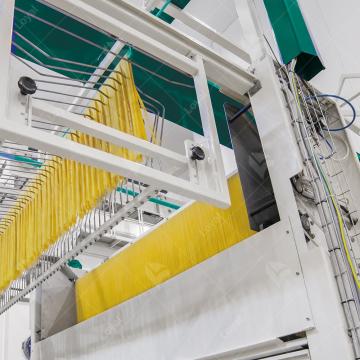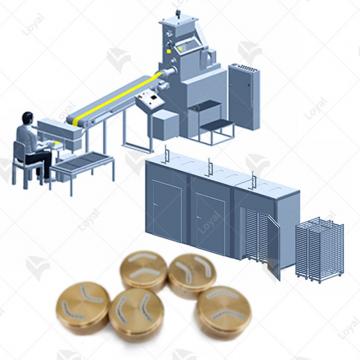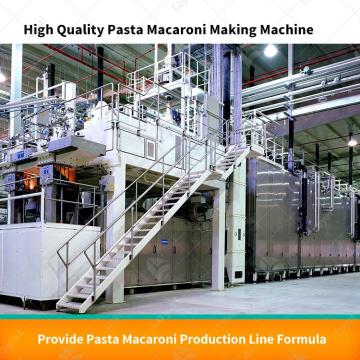Innovating Pasta Production: Unique Fully Automatic Solutions for Dry Pasta Manufacturers
Innovating Pasta Production: Unique Fully Automatic Solutions for Dry Pasta Manufacturers
Introduction
Shandong Loyal Industrial Co., Ltd. has incorporated advanced technologies from FAVA and UTF in the production of its macaroni.In the dynamic realm of pasta production, a remarkable evolution has unfolded through the integration of innovative technologies. This article embarks on a journey to unveil the transformative impact of fully automatic solutions for dry pasta manufacturers. We delve into the uniqueness that defines the integration of advanced automation in the pasta manufacturing process, shedding light on a new era in the industry.
Revolutionizing Dry Pasta Manufacturing
To appreciate the significance of fully automatic solutions, it's essential to understand the historical context of traditional dry pasta production methods. The paradigm shift brought by these solutions in the pasta manufacturing industry is profound, emphasizing efficiency, precision, and uniqueness. This section explores the new era in dry pasta production, highlighting the departure from conventional methods.

Fully Automatic Solutions Defined
In defining fully automatic solutions for dry pasta manufacturing, a comprehensive examination is warranted. Key components and functionalities that set these innovative systems apart are explored. The impact of these solutions on streamlining processes, ensuring consistency, and enhancing overall efficiency is detailed, underscoring their transformative role.
Technological Innovations Shaping Unique Solutions
The revolution in dry pasta manufacturing is fueled by cutting-edge technologies. This section delves into the integration of artificial intelligence, robotics, and unique features that optimize pasta production. Sustainability takes center stage as a guiding principle, with exploration into its distinctive aspects within innovative solutions, ensuring a harmonious blend of technology and environmental responsibility.
Benefits of Fully Automatic Dry Pasta Manufacturers
The advantages of embracing fully automatic solutions are multifaceted. Streamlined workflows and increased production efficiency are witnessed, coupled with precision and consistency in pasta quality through automation. This section highlights the reduction in environmental impact and resource consumption, aligning with sustainable practices embraced by modern pasta manufacturing.

Real-world Applications and Success Stories
In the realm of dry pasta manufacturing, real-world applications of fully automatic solutions have yielded remarkable success stories. Notable instances include renowned manufacturers who have embraced cutting-edge technologies to revolutionize their production processes.
One exemplary case involves a pasta manufacturer that integrated fully automatic solutions to enhance precision and efficiency. By incorporating advanced robotics and artificial intelligence, the company achieved a significant reduction in production time and resource utilization. The result was a substantial increase in output without compromising quality.
Industry leaders who have spearheaded these transformations provide invaluable insights. Their experiences shed light on the unique aspects of implementing fully automatic solutions. Leaders emphasize the need for a strategic approach, comprehensive employee training, and continuous innovation to stay ahead in a competitive market. These insights serve as guiding principles for others contemplating the integration of such advanced technologies.
Challenges and Solutions
While the benefits of fully automatic solutions in dry pasta manufacturing are evident, navigating potential challenges is crucial for a successful transition. Acknowledging these challenges, the industry has devised innovative solutions to ensure a seamless integration process.
Challenge 1: Initial Implementation Costs
One common challenge is the initial cost associated with adopting fully automatic systems. To address this, industry experts recommend exploring financing options, government incentives, and strategic budget planning. Collaborative efforts between manufacturers and technology providers have led to creative financing models, making these solutions more accessible.
Challenge 2: Workforce Adaptation
Integrating fully automatic solutions may pose challenges in terms of workforce adaptation. To overcome this, proactive training programs and educational initiatives have been implemented. Manufacturers collaborate with educational institutions and provide ongoing training to equip their workforce with the necessary skills to operate and manage the advanced systems effectively.
Future Trends and Innovations
The article peers into the future, exploring emerging technologies shaping the automated pasta manufacturing landscape. Anticipated developments in efficiency, sustainability, and quality control are discussed, providing a glimpse into the evolving role of fully automatic and unique solutions in defining the future of dry pasta production.
Conclusion
In recapitulating the transformative impact of fully automatic and unique solutions on dry pasta manufacturing, it's evident that the industry stands at the threshold of innovation. Closing thoughts reflect on the ongoing journey towards more efficient, sustainable, and uniquely tailored pasta production processes. This article invites stakeholders to embrace the future with open arms, recognizing the potential for continual advancement.

Common Questions about Fully Automatic Dry Pasta Manufacturers
As the exploration of fully automatic solutions for dry pasta manufacturing unfolds, common questions arise. This FAQ section addresses inquiries that stakeholders may have regarding this revolutionary approach.
1. How do fully automatic solutions differ from traditional pasta production methods?
Fully automatic solutions represent a departure from manual and semi-automated processes. The integration of advanced technologies ensures higher efficiency, precision, and a streamlined production workflow.
2. What components define fully automatic systems in dry pasta manufacturing?
These systems encompass a range of components, including advanced machinery, robotics, artificial intelligence, and unique features designed to optimize various stages of pasta production.
3. What impact do fully automatic solutions have on sustainability in pasta manufacturing?
Sustainability is a cornerstone of these innovations. The reduction in environmental impact and resource consumption aligns with modern practices, making fully automatic solutions an environmentally responsible choice.
4. Are there real-world examples of successful implementations?
Yes, numerous dry pasta manufacturers have embraced fully automatic solutions with remarkable success. Case studies highlight improved efficiency, sustainability, and distinctive outcomes achieved through these implementations.





